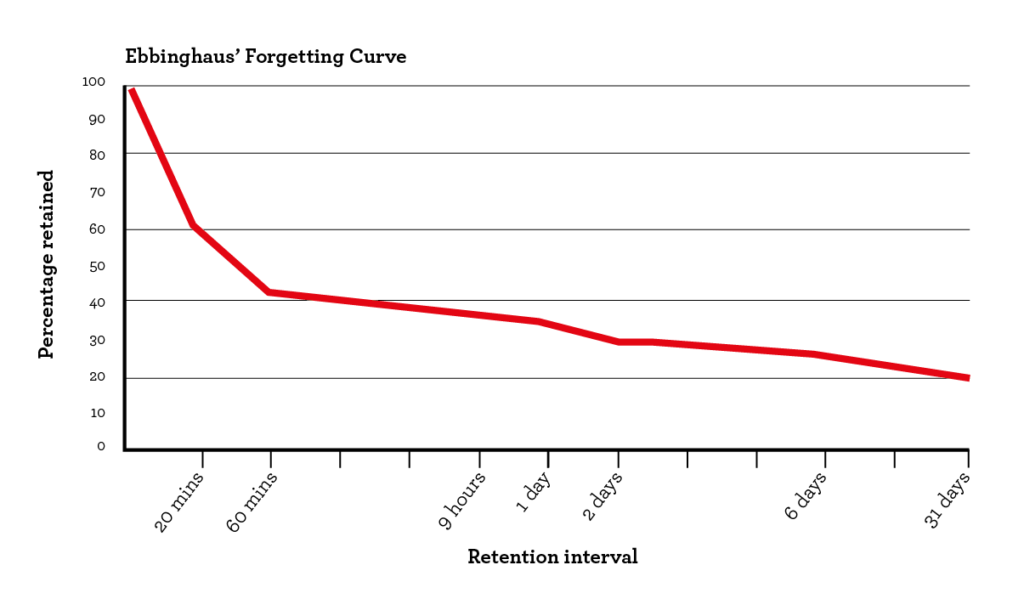
Whether you think about learning a new language or simply picking up a skill, a lot of us may assume that trying to get as many minutes or hours into learning, all at once, might help.
But the more we cram, the less we tend to remember. And for anyone who has had last-minute cramming sessions before a university exam know that, no matter how much information we try to stuff in there, we won’t remember everything.
In fact, on the contrary, the less we spend on trying to learn everything at once, and instead of spacing our study sessions out across multiple days in smaller bites, the better actually will learn.
What is the Spacing effect?
This method plays on what is known as the spacing effect. And the act of spacing out our study sessions to increase recollection and information input is a technique that many language learners called spaced repetition.
First identified by the German psychologist and pioneer in memory, Hermann Ebbinghaus, the spacing effect has been noted to help prevent forgetting information easily, as Ebbinghaus found that an increase in time intervals between each period of recall reduces the probability of forgetting.
Why it happens
In his most seminal work on forgetting curves, Ebbinghaus found that retaining memories of new information dropped drastically in the initial twenty minutes of input. Yet, after a day or so, the percentage of information retained leveled off.
What this means is that if you intentionally space out learning something over multiple sessions, across multiple days, the likeliness of you forgetting will be slimmer as the days go by. This is why cramming as much information as possible over a single period is not effective.

Further supported by countless studies on recognition, cued-recall, and free-recall, the spacing effect has several explanations as to why it makes it such an effective way to learn.
- Semantic priming — This refers to the process of associating the specific word with the previous one to help absorb the information better. Studies found that when it came to massed repetition learning, there is a reduction in semantic processing as the first word is often primed with a mental representation. The more words you then try to cram into your brain at once, the less effective that processing becomes because you’re overstuffing the mental models primed.
- Deficient processing — This view on memory learning notes that our brains do not pay much attention to the later presentations of information that appear after the initial one. This is particularly true when it comes to cued-memory tasks. It may also lend itself to the idea of another cognitive bias known as the serial position effect in motion, where we have less chance to remember things that occur in between, instead of at the beginning or end.
While generally, the spacing effect can be a great way to learn, not every task is equal. Depending on the area of domain or complexity of the skill, the spacing effect may not have as much advantage for some as others.
As one study showed, when it came to a task revolving around airplane control simulation, the effect size for spacing was relatively small. This implies that for this given task, spacing out the learning was not worthwhile. However, when it came to spacing learning for surgical skills, there were benefits to using the spacing effect.
How we can apply it
Learning is not something that comes naturally but is something we need to learn ourselves.
The spacing effect is a powerful cognitive bias that can work to our advantage the moment we become aware of it. By effectively utilizing the spacing effect, we can learn things faster, better, and generally improve our lives — whether that be at school, at work, or simply for personal development.
One of the most common ways that the spacing effect is utilized through the act of spaced repetition is via apps such as Anki or Quizlet. These are tools that help people integrate a spaced approach to learning vocabulary or concepts via digital cue cards. It provides schedules for the user to follow, all the while not taking too much time out of their day.
Another way to make sure we apply the spacing effect to learning and studying is to consciously make sure to schedule a period for review. Just as seen in the graph above regarding Ebbinghaus’ forgetting curve, the percentage of information retained falls off drastically within the first few hours. While it does even out after several days, there is still a slight dip down, meaning that the less we spend on reviewing the information, the more likely we’ll forget it.
Remember, learning is a process, not a single act alone.
Things take time to be etched into our long-term neural pathways. Simply stuffing our brains with as much information at a given time, and then moving on will never do our minds justice. Even if a single study session is shorter, but spaced out across multiple days consistently with the review, this is significantly more effective in learning than having fewer, but longer intense sessions.










